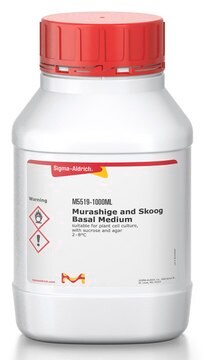B1522
Basal Medium Eagle
With Earle′s salts and sodium bicarbonate, without ʟ-glutamine, liquid, sterile-filtered, suitable for cell culture
Pharma Manufacturing
Synonym(s):
BME
About This Item
Recommended Products
product name
Basal Medium Eagle, With Earle′s salts and sodium bicarbonate, without L-glutamine, liquid, sterile-filtered, suitable for cell culture
Quality Level
sterility
sterile-filtered
form
liquid
technique(s)
cell culture | mammalian: suitable
impurities
endotoxin, tested
components
L-glutamine: no
NaHCO3: yes
Earle’s salts (5% CO2): yes
shipped in
ambient
storage temp.
2-8°C
Looking for similar products? Visit Product Comparison Guide
General description
Application
- as a component in the culture medium for cochlear organotypic cultures and salicylate treatment
- to maintain cerebellar granule neurons (CGNs) to determine if there is a system that regulates the distribution and/or group dynamics of axonal mitochondria
- in the preparation of cortical slices, serum-free medium, and slice culture medium for slice overlay assay to study the influence of extracellular signals on neuronal development
Reconstitution
supplement
Storage Class Code
12 - Non Combustible Liquids
WGK
WGK 1
Flash Point(F)
Not applicable
Flash Point(C)
Not applicable
Certificates of Analysis (COA)
Search for Certificates of Analysis (COA) by entering the products Lot/Batch Number. Lot and Batch Numbers can be found on a product’s label following the words ‘Lot’ or ‘Batch’.
Already Own This Product?
Find documentation for the products that you have recently purchased in the Document Library.
Customers Also Viewed
Articles
Cell culture protocol for passaging and splitting suspension cell lines
Our team of scientists has experience in all areas of research including Life Science, Material Science, Chemical Synthesis, Chromatography, Analytical and many others.
Contact Technical Service
